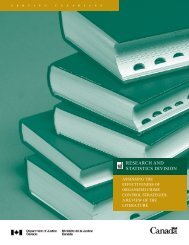National Threat Assessment 2008. Organised Crime - Politie
National Threat Assessment 2008. Organised Crime - Politie
National Threat Assessment 2008. Organised Crime - Politie
You also want an ePaper? Increase the reach of your titles
YUMPU automatically turns print PDFs into web optimized ePapers that Google loves.
was gathered on a total of 119 cases of abuse in an employment situation,<br />
54 of which were qualified as exploitation within the meaning of Section 273f<br />
of the Penal Code. The number of listed cases of exploitation is shown in table<br />
2. However, the totals cannot simply be added together, as one case may be<br />
related to exploitation in several sectors. It is also unclear to what extent these<br />
are cases related to organised crime.<br />
2.6.4 Criminal organisations<br />
The ethnic composition of the criminal organisations in the 23 29 cases analysed<br />
was generally heterogeneous. As well as Dutch suspects, there was also a high<br />
number of suspects of Turkish origin. Other frequently occurring countries of<br />
origin were Morocco, Romania, Bulgaria and Surinam. The number of suspects per<br />
group of perpetrators varied between 3 (the minimum in this selection) and 55.<br />
An analysis of data from the Public Prosecutor database (‘OM-data’) shows that<br />
human trafficking regularly occurs in combination with drug trafficking. Other<br />
secondary offences included in charges in human trafficking cases were violent<br />
supporting offences such as sexual assault or rape, assault or intimidation.<br />
2.6.5 Consequences for Dutch society<br />
The consequences for society consist of the harm to victims of human<br />
trafficking. Due to most victims’ reluctance to file a report and the limited<br />
possibilities available for detecting human trafficking, no reliable estimate of<br />
the number of victims can be provided. It is clear, however, that each year at<br />
least several hundreds of victims suffer direct and serious harm as a result of<br />
human trafficking. The severity of the exploitation is primarily shown in the<br />
way in which the victims are treated. Victims of both types of human trafficking<br />
undergo psychological violence: they often have limited freedom of choice,<br />
as they find themselves in a position of dependency. In addition, the exploiters<br />
use physical violence against victims in many cases.<br />
It should be noted that in some cases of exploitation the victims apparently<br />
preferred to surrender (part of) their earnings rather than remain in the<br />
more impoverished or more hopeless circumstances of their past. However,<br />
the victims suffer financial loss, as they have to surrender (some of) their<br />
earnings. Especially in the case of forced prostitution, the victims’ physical<br />
integrity is also in jeopardy.<br />
29<br />
A total of 23 criminal investigations, of which 18 cases related to exploitation in the prostitution<br />
sector and five to exploitation in other sectors, two of which involved illegal cannabis cultivation.<br />
chapter 2 – Illegal markets<br />
71








